

Earthkeeping and the Poor: Assessing the Environmental
Sustainability of Development Projects
Harry Spaling*
The King's University
Collegehspaling@kingsu.ab.ca
9125 - 50 Street
Edmonton, AB, Canada T6B 2H3
Janelle Zwier and David Kupp
World Vision
CanadaDavid_Kupp@wvi.org
6630 Turner Valley Road
Mississauga,
ON, Canada L5N 2S4
From: PSCF 53
(September 2001): 142-151.Caring for creation is an integral part of development work among the poor. Development projects that rely directly on natural resources such as soil, water, plants, and animals for meeting basic human needs of clean drinking water, food, shelter, and livelihood must be environmentally sustainable if the benefits of the project are to be continued. Environmental assessment is one way of evaluating the sustainability of projects before implementation. This paper describes a six-step process suitable for small, community-based projects typical of Christian development agencies. An agriculture project in Uganda demonstrates an application of this process.
H
umans have heavily impacted God's creation across the entire planet. Degradation is evident in polluted air and water, erosion of fertile soil, destruction of habitats, disappearance of plant and animal species, holes in the planet's ozone layer, and global climate change. These impacts originate in both the industrialized "North" and the developing "South," but the "South" bears an extra share of the consequences. The poor depend more directly on life-sustaining resources for meeting basic human needs--food, shelter, and livelihood. But in the struggle to meet these needs, resources are often degraded through excessive cultivation, inadequate sanitation, over-fishing, deforestation, and other forms of exploitation. Thus, people live with environmental stresses that can push them over the edge toward hunger and failing health, without socio- economic cushions. Poverty and environmental degradation are closely linked.Development workers typically plan projects to use resources for the alleviation of poverty. Anticipation of the effects of development can be critical for long-term success of those actions focused on clean drinking water, increased food production, renewable energy sources such as wood, charcoal or biogas, forestry products, and other activities reliant on natural resources. These are more likely to be effective and less polluting if their potential environmental impacts are known and addressed.
Environmental assessment is one way of determining the effects of development projects. Broadly, this process identifies and evaluates environmental changes attributable to a particular project before implementation. Such assessment is typically applied to industrial mega-projects, but its basic framework and tools hold promise for assessing the sustainability of smaller, community-based projects. The results can be used to enhance such improvements as fuel-efficient wood stoves and to avoid or minimize adverse impacts, perhaps by redesigning the project with different technology or inputs, changing its location or timing, or other modifications.
For example, an environmental assessment of an oxen-restocking project was carried out in northern Uganda in 1998. The staff of the Christian Charity Center Uganda, a nongovernment development organization, and members of local communities participated in the assessment. Results showed that oxen-restocking improved soil fertility through the introduction of manure. Deeper tillage and burial of weeds decreased the need for burning. Higher income from increased yields reduced the pressure on local forests for other income sources such as charcoal production or firing of bricks. Adverse impacts included lower water quality at sites where oxen are watered from community water supplies, and increasing scarcity and fragmentation of land as demand for oxen-cultivated land increases. The environmental assessment suggested that the impact on water quality be mitigated through designating separate watering sites, and that land tenure follow a family system of land inheritance rather than the traditional practice of subdividing land for individuals. This example is examined in detail later.
All people are mandated by Scripture to care for creation, especially in their local areas (Gen 2:15, Lev. 25). Many Christian development agencies and their partners are aware of this, but may be poorly equipped and lack institutional capacity for implementation. In this paper,1environmental assessment is proposed as a tool for Christian development workers. It should not be viewed as obstructing development work, nor as elevating creation above human needs, but as enhancing development projects reliant on natural resources so that the poor benefit through improved food production, clean drinking water, available materials for shelter, and adequate livelihoods based on sustainable economic development. Environmental assessment can contribute to the provision of basic human needs and productive livelihoods through careful use and conservation of creation's resources.
This paper focuses on applying environmental assessment to small, community-based projects typical of Christian development agencies. It begins with a brief rationale, then describes a six-step process for assessment, followed by application to an agriculture project in Uganda.
Rationale for Environmental Assessment
There are at least three reasons why Christian development workers should apply environmental assessment. First and foremost, it demonstrates biblical earthkeeping.2
The Bible calls all people to care for God's creation, fruitful and teeming with life (Gen. 1:22). This verse means to keep the earth with all its beauty, diversity, and abundance so that it reveals the Creator through evocation of human wonder and awe. A diverse, abundant creation gives evidence of God's providence, even as the Creator's bounty supplies resources needed for sustaining life, including ecological processes that replenish air and water, regenerate soil fertility, and reproduce plant and animal populations. A fruitful creation glorifies and praises its Creator (Ps. 104). A degraded creation hinders God's revelation, abuses his providence, and detracts from his praise.
As stewards, humans have a special place in creation, for the Creator entrusted it to humankind (Gen. 2:15). Humans may enjoy the fruits, but they should not destroy the fruitfulness of creation. Developing, using, conserving, or preserving resources must always occur within the framework of stewardship. This means caring in such a way that the Creator is revealed, life sustained, and God is praised.
Developing, using, conserving,
or preserving resources
must always occur within
the framework of stewardship.
With humanity's fall, humans have not been faithful stewards and creation has suffered. All creation, along with people, longs to be redeemed (Rom. 8:21). Christians must actively participate in renewing and restoring the present creation in anticipation of a future creation that will be fully redeemed through Jesus Christ (Col. 1:20), a home to God and his people (Rev. 21:3). Stewardship is a call for Christians to care for the present earth in expectation of this homecoming. Environmental assessment is one way of responding to this call.
Secondly, environmental assessment can improve the effectiveness and efficiency of projects utilizing resources such as water, soil, trees, plants, animals, and fish. By considering ecological factors and processes, it can help ensure sustainability into the foreseeable future. Also, environmental assessment information may be used for evaluating technology options, selecting suitable sites, or setting harvest limits and schedules, thus avoiding costly and inappropriate technology, unsuitable locations, or over- harvesting. The amount of time and money spent on environmental assessment is relatively small, and it is a wise investment in project sustainability.
Finally, environmental assessment can satisfy policy and legal requirements of partners or donors.3
For example, Canadian federal law requires that all public funding of international development projects be subject to such assessment. This means that Christian agencies receiving Canadian funds for development work must conduct an environmental assessment and report its results to the government. Increasingly, governments in host countries also are requiring such reports. Malawi and Ghana, e.g., may require nongovernment organizations to assess their community projects as a condition for approval of water supply systems, health clinics, or farm inputs such as fertilizer and pesticides.
Some church and parachurch agencies have their own environmental policies promoting stewardship and assessment. Both World Vision Canada and the Christian Reformed World Relief Committee have environmental assessment policies and procedures with which overseas partners must comply. Agencies with this capacity are more likely to be viewed favorably by external partners, donors, and supporting constituencies. In summary, environmental assessment is a practical way of implementing the biblical call for earthkeeping, enhancing sustainability of projects reliant on natural resources, and strengthening relationships with those involved.
A Six-Step Process For Environmental Assessment
The focus of environmental assessment is typically on a future project so that potential changes may be anticipated. Information should be systematically collected, analyzed, and evaluated. A six- step process is proposed below, based on accepted environmental assessment practice at the screening level.4
Step 1: Describe the environmental setting
A succinct description of the project's surroundings is needed (Table 1). Possible sources of information include direct observation, local residents, environmental groups, government departments and universities, and international agencies such as the Food and Agriculture Organization and the World Wildlife Fund.
Step 2: Identify valued environmental components
Since no environmental assessment can study every aspect of the environment,
a practical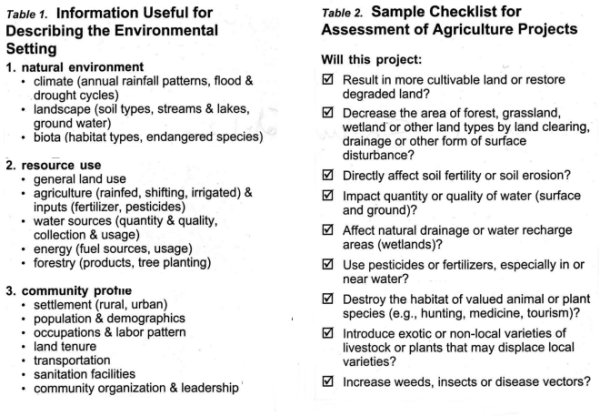 approach is to collect and analyze information only for relevant and
valued environmental components (that is, natural resources or processes
recognized as important in a community). Value may be determined by its utility
for humans such as water for drinking, soil for farming, plants for medicine or
its ecological function or uniqueness, including wetland for water recharge and
forest habitat for hunted game. One way of selecting valued environmental
components is to identify resources or processes on which a proposed project
would depend, or with which it may interact, for example, crop production
depends on soil type and is influenced by erosion.
approach is to collect and analyze information only for relevant and
valued environmental components (that is, natural resources or processes
recognized as important in a community). Value may be determined by its utility
for humans such as water for drinking, soil for farming, plants for medicine or
its ecological function or uniqueness, including wetland for water recharge and
forest habitat for hunted game. One way of selecting valued environmental
components is to identify resources or processes on which a proposed project
would depend, or with which it may interact, for example, crop production
depends on soil type and is influenced by erosion.
Only those environmental components with recognized specific value should be investigated further. Appropriate local information should be collected and measured such as quantity and quality of drinking water, depth of topsoil, and area of forest.
In this second step, indigenous values should be recognized. Nonwestern perceptions about environmental aspects may differ from those perceived in western cultures. For example, in Africa, monkeys often are considered agricultural pests, whereas termites, a pest in North America, are valued as food for fish ponds. These differences call for extensive local consultation. Since values are likely to vary among communities, and other stakeholders, these differences may lead to a wide range of valued environmental components that reflect various viewpoints.
Step 3: Estimate changes in valued environmental components
Estimating potential future changes in valued environmental components is a challenging task. Three guidelines are suggested. First, the current baseline should be compared with two future environments: the valued environmental components with, and without, the project. It is necessary to distinguish between project-induced impact and natural variability. Change may occur naturally without a project. Impact occurs only if a project affects a valued environmental component. For example, a 200-hectare forest, valued for fuel wood, game and medicinal plants, may be reduced fifty hectares by land clearing associated with a proposed agriculture project. Without this activity, no change in forest area need be anticipated. Thus, a twenty-five percent decrease in forest area is a likely impact of this proposed project.
Second, although various methods for assessment have been developed, these usually require precise data and high level computers and expertise. Checklists and matrices do not necessarily require these. A checklist is a list of standard questions to be raised when assessing environmental impacts (Table 2). A matrix involves a table showing interactions between valued environmental components and the project. A matrix is demonstrated in the Ugandan case below. Checklists and matrices provide a systematic process for estimating impacts, and are relatively easy to use.
Third, a particularly helpful way of collecting and analyzing environmental information is by means of participatory rapid appraisal. This involves semistructured techniques used in field work by a multidisciplinary team to provide quick, timely, and focused information (Table 3).5
These methods are easily applied requiring minimal data, expertise, time, or technology and are well suited for community participation. Participatory rapid appraisal is already commonly employed by development agencies for collecting and analyzing social or economic data such as population, child health, and family income. Its familiarity offers considerable potential for estimating environmental impacts.
Step 4: Assess Significance of Environmental Changes
Once future changes have been estimated they must be evaluated, since impacts are not all equally important. Distinguishing the more important changes is known as significance assessment.
One approach to assessing significance involves criteria such as magnitude (size), duration (how long), timing (when, how often), location (where) or reversibility (permanent or temporary). Ultimately, however, value judgments about the acceptability of anticipated impacts are required. These judgments may be based on (1) earthkeeping norms (preserving fruitfulness or diversity), (2) environmental regulations (standards for pesticide use), (3) ecological uniqueness (preservation of rare or endangered species, with special areas or habitats), (4) human aspirations and needs (open space, medicinal plants), (5) distribution of impacts by gender or social groups (women, children, income level), and (6) aesthetics (visual quality).
Most importantly, communities affected by the project should participate fully in judging its acceptability. Local values should be incorporated in making judgments about anticipated environmental changes. Where local values clash with external ones, priority normally should be given to those people most directly affected. The way in which communities determine significance is also important. Indigenous decision-making processes should be respected and the outcomes usually supported.
Step 5: Determine project status
Results of significance assessment are used to determine the status of a project. Three possible outcomes are:
1. No significant adverse impacts are anticipated, and the project proceeds as
planned,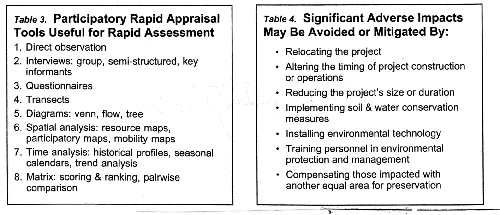
2. Significant adverse impacts are anticipated, with avoidance or mitigation possible through project modification or implementation of preventative or restorative measures (Table 4), or
3. Significance of adverse impacts seems unacceptable or unknown, and a more comprehensive environmental assessment is required, or the project abandoned.
Step 6: Monitoring and Evaluation
Evaluation should include plans for regular monitoring during implementation. Monitoring is necessary to gauge the effectiveness of mitigation measures, to prepare for unanticipated environmental changes, and to strengthen the environmental baseline for similar projects planned elsewhere. Periodic evaluation is necessary to assess the long-term sustainability and to gain knowledge for new projects. This can be combined with normal monitoring and evaluation.
The above six steps of environmental assessment provide a systematic way to identify and assess the impacts of a proposed project on valued environmental components. For a project to be effective, this information must be integrated into the project cycle.
Integrating Assessment into the Project Cycle
Environmental assessment should be an integral component of
decision-making, not a separate process. As such, it can provide timely,
relevant information at various stages (Figure 1). Assessment must begin early,
normally at the time of project conception. It is then that major decisions are
usually made, sometimes irrevocably. Early consideration can influence site
selection, future outcomes, and allocation of money, time, and personnel, thus
avoiding costly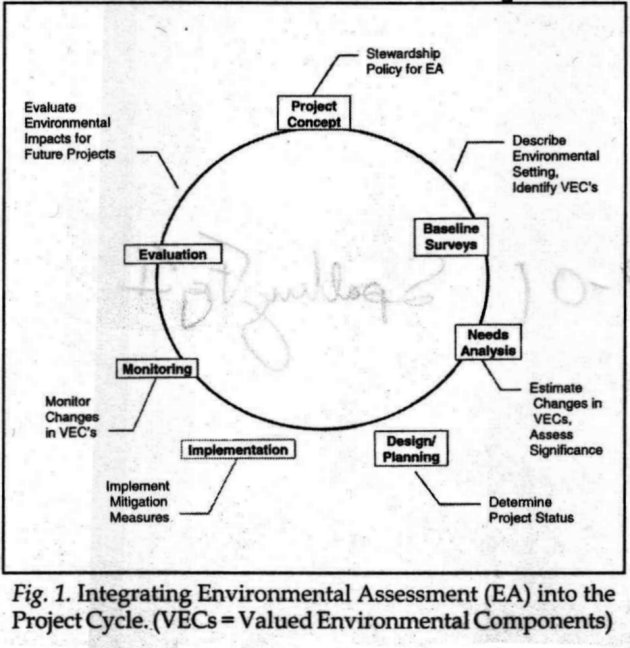 delays or corrective action later.
delays or corrective action later.
Information on the environmental setting can be used to identify particular valued environmental components. More detailed data about each valued environmental component can be collected concurrently with community baseline surveys on health, food production, income, literacy, etc. Data on water, soils, plants, and wildlife can be easily integrated into the process.
Just as data from baseline surveys are used for need analyses, environmental information can help in estimating changes in valued environmental components attributable to a project. Environmental baselines also serve in assessing significance and in setting acceptable levels of environmental impact. For example, data about land use can help a community decide which watersheds may be cleared for lowland rice production and which must be preserved to ensure adequate stream flow for water supply.
Such information can be used to determine a project's status. Projects with no significant environmental impacts may proceed as planned. Where impacts are significant, the project design may be modified so that beneficial effects are enhanced and adverse impacts are avoided or minimized. Site, schedule, construction operations, or incorporation of environmental protection safeguards such as soil erosion control, tree planting, and the selection of an appropriate distance from a watercourse may be reconsidered. In cases where a project is not environmentally sustainable, overhaul or even cancellation may be warranted.
Monitoring can be integrated with regular activities. For instance, crop yields can easily be checked along with monitoring for changes in soil fertility, risk of erosion or areas of cleared land. Regular information collection can help manage any unforeseen impacts. Project evaluations should compare estimated to actual impacts, and appraise performance in collecting, reporting, and using environmental information. This feedback can provide valuable input for future planning and implementation, and for improving the environmental assessments thereof.
To summarize, the integration of environmental assessment into each stage of the project cycle is more likely to produce sustainable resource-based projects that achieve planned results over the long-term.
Case Study
Christian Charity Centre Uganda (CCCU) is a small non-governmental organization located in the town of Lira in Northern Uganda serving the districts of Lira and Apac. In 1997, CCCU commenced an oxen-restocking project in the Apac district following the eradication of oxen during an extended period of instability and violence.6
CCCU re-introduced oxen to increase food security and nutrition in the region, as well as to revitalize traditionally sustainable agriculture practices. Through a revolving loan scheme, pairs of farmers are able to purchase teams of oxen with one plough. CCCU provides training in oxen keeping and ploughing. Project results are very successful, farmers more than doubling their crop yields in a single season.
Despite its short-term results, long-term environmental sustainability has not been considered. Further, CCCU has a need to develop its capacity for applying environmental assessment to other future projects being considered for funding by its partners. Thus, an assessment of this oxen-restocking project would help evaluate its long-term sustainability as well as build the capacity for conducting environmental assessment elsewhere. Its assessment was therefore carried out in the fall of 1998, after about one year of operation. This evaluation of an existing, rather than planned, project was justified by uncertainties about long-term viability and concomitant provision of training for future projects. Atar, the first village to receive oxen, was selected as a representative site to limit the scope of the environmental assessment.
Approach
Community participation was critical. Project beneficiaries were consulted through a community meeting and informal interviews. Techniques of participatory rural appraisal, including community mapping, farm sketches and trend lines, were used to collect and record information about the local setting.
Assessment began with a community meeting at which the team was formally introduced and the environmental assessment process explained. The team used a mapping exercise where community members drew, on bare ground, a map of their parish showing key environmental features such as water sources, grazing land, vegetation types, roads, wetlands and sites exhibiting environmental degradation (Figure 2).
Rapid appraisal techniques were also used in meetings with individuals. They
were asked to draw trend lines representing change in environmental or community
components such as soil erosion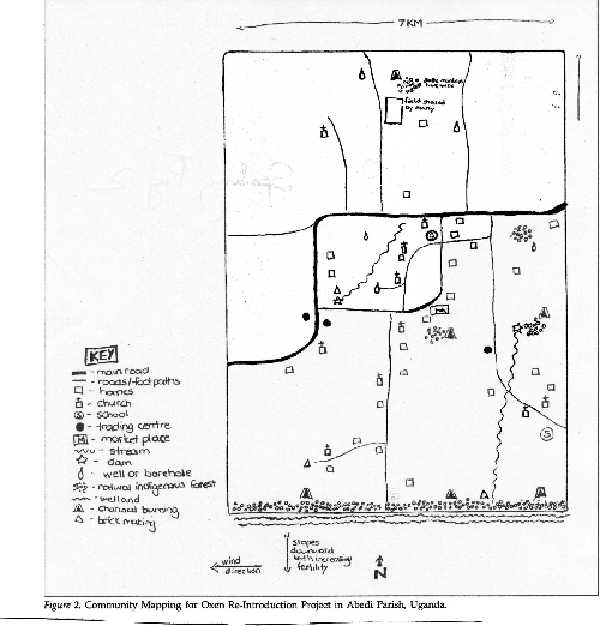
and population growth. Sketching was also employed to record information about their farms. In addition, information was gathered from individual oxen owners, using informal interviews. These techniques facilitated community involvement and provided a record of the environmental setting, raising awareness and identifying concerns about the local environment.
Information gathered from the community and individuals was used to refine the general list of valued environmental components initially prepared by the assessment team. This list included soils, erosion, vegetation, animals, water, farming practices, land tenure system, and energy. Additional valued environmental components identified as valuable by the community included termites, burning, bees, market, family size, education, and seed quality. Thus, the selected valued environmental components represented values from the community and the assessment team.
Results
Once chosen, the assessment team estimated impact on each valued environmental component. These were arranged into a matrix for impact analysis and significance assessment (Table 5). Each was analyzed for any change attributable to the project, whether negative, positive or neutral in impact. The significance of any impact was assessed for each valued environmental component and ranked on a scale ranging from 0 to 5 (0 = no impact; 5 = severe or permanent impact). Degree of confidence in analysis and assessment were also ranked to incorporate uncertainties among the assessors, with 1 as unknown and 5 as positively known.
The overall impact of the Apac oxen-restocking project was evaluated as positive (Table 5). Most of the environmental parameters were decidedly positive in impact. The oxen-restocking project, with its introduction of sustainable agricultural practices largely benefitted the local environment. Increased soil fertility was particularly evident with the introduction of manure. Earlier, deeper tillage and the burying of weeds reduced the need for burning. Increased crop yields and improved food security decreased pressure on local forests for income generating activities such as charcoal burning and brick-firing. Training in agroforestry and tree nursery establishment was also incorporated into the training for oxen ploughing. This training as well as more general environmental education contributed significantly to the environmentally positive impacts of the project.
Only a few adverse impacts stand out. Water quality has decreased in some sites where community water supplies are also used for watering oxen. Also, the land tenure system may be adversely affected because landowners anticipate increasing land scarcity and greater fragmentation of their holdings, as oxen cultivate more patches.
The threats to water quality and land tenure may be mitigated through measures that can avoid, minimize or correct. Changes to water quality can be minimized by designating some watering sites exclusively for oxen, supported by an education campaign on water sanitation. An option being considered by CCCU for mitigating the adverse effects of the project on land tenure and use is to encourage the allocation of inherited land parcels jointly to family members for their collective use, rather than following the traditional practice of dividing land into segments for individual inheritance.
Monitoring and evaluation of environmental impacts have been integrated into
the project cycle. For example, CCCU will monitor soil fertility along with crop
yields on a regular basis. Monitoring of key valued environmental components is
needed to assess mitigation measures and watch for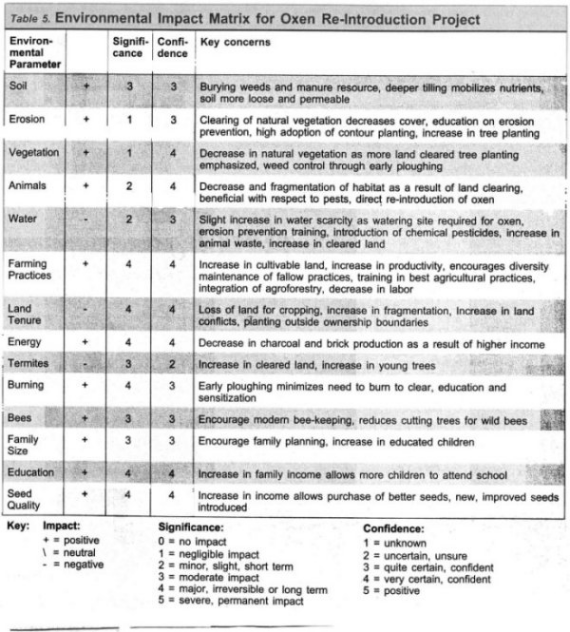 unexpected impacts.
Monitoring data are useful for comparing estimated and actual impacts of the
project, and for conducting assessments in the future.
unexpected impacts.
Monitoring data are useful for comparing estimated and actual impacts of the
project, and for conducting assessments in the future.
Lessons Learned
Several lessons have been learned from the application of environmental assessment to oxen restocking. The case study demonstrates that environmental assessment can provide important information for a project. Information about soil fertility, water sources, and land tenure is useful for managing the project toward long-term sustainability. Another valuable source of information is the environmental baseline, potentially useful for monitoring positive and adverse environmental impacts of any project.
While the staff of CCCU has been enabled to evaluate the long-term environmental sustainability of the oxen re-introduction project, the benefits reach much further. Training in the methodology and practice of environmental assessment can now be extended to other projects. Staff participation has stimulated environmental awareness, so this is now considered in other projects. Overall, it has improved the capacity of CCCU to promote and implement projects that are more likely to be environmentally sustainable.
A shortcoming in this case is that the environmental assessment occurred during the operational phase. Ideally, it should have begun earlier in the project cycle. Despite poor timing, CCCU was still able to identify impacts and to address them through mitigation and monitoring. While we hope this is not the norm, it does show that an environmental assessment of an existing project can improve an ongoing operation, making it more tangible than a planned one and thus appropriate for training purposes.
Notwithstanding its timing, this case also illustrates that environmental assessment can be integrated into the project cycle, enabling each component to be linked to specific steps in the process. In the oxen project, an environmental baseline now exists for integration with the community baseline, and its monitoring and evaluation are being adapted to include valued environmental components. Integration of environmental assessment into the project cycle provides a holistic approach to managing long-term sustainability.
All people are called to exercise stewardship of God's creation. The poor, too, long to respond to this call in their locales. Christian development workers have an obligation to enable this calling to be filled. Environmental assessment is a practical way of demonstrating the Christian calling to be caretakers of creation in the service of the poor.
©2001
Notes
1Research for this paper received financial support from the PEW Charitable Trusts through the Council of Christian Colleges and Universities, Social Sciences and Humanities Research Council of Canada, and World Vision Canada. Two reviewers provided positive suggestions.
2For more detailed biblical perspectives on caring for creation see C. DeWitt, Earth-wise: A Biblical Response to Environmental Issues (Grand Rapids, MI: CRC Publications, 1994); W. Granberg-Michaelson, Tending the Earth: Essays on the Gospel and the Earth (Grand Rapids: Eerdmans, 1987); F. Van Dyke, et al., Redeeming Creation: The Biblical Basis for Environmental Stewardship (Downers Grove, IL: InterVarsity Press, 1996); L. Wilkinson, Earthkeeping in the 90s: Stewardship of Creation (Grand Rapids: Eerdmans, 1980). Resources that link caring for creation and the poor include D. Hallman, Ecotheology: Voices from South and North (Geneva: WWC Publications, 1994); C. DeWitt and G. T. Prance, eds., Missionary Earthkeeping (Macon, GA: Mercer University Press, 1992); W. D. Roberts and P. E. Pretiz, eds., Down-to-Earth Christianity: Creation-Care in Ministry (Wynnewood, PA: Association of Evangelical Relief and Development Organizations, and Evangelical Environmental Network, 2000).
3The idea of environmental assessment originated with the U.S. National Environmental Policy Act in 1969. Most countries now have environmental assessment laws or policies, although progress in the South has been hampered by a perceived priority of human need over environmental concerns and the lack of institutional capacity for environmental assessment. However, these issues are being addressed by the increasing awareness of the link between poverty and the environment, and by establishing administrative units, staff and procedures for environmental assessment. See Lee Norman and Clive George, Environmental Assessment in Developing and Transitional Countries (Chichester, England: John Wiley & Sons, 2000).
4Environmental assessment may be completed at various levels of sophistication depending on the complexity of the proposed project and its environmental sensitivity. Screening level EA is the most basic. It is designed for rapid appraisal of impacts from small projects unlikely to have major impacts. Other, more comprehensive forms of environmental assessment, normally require detailed scientific study by experts and are usually subject to public and regulatory review. Resources on screening level environmental assessment include Canadian International Development Agency, Handbook on Environmental Assessment of Non-Governmental Organizations and Institutions Programs and Programs (Ottawa: Canadian Partnership Branch, Canadian International Development Agency, 1997); Dean Pallen, Environmental Assessment Manual for Community Development Projects (Ottawa: Asia Branch, Canadian International Development Agency, 1996).
5National Environment Secretariat, Participatory Rural Appraisal Handbook: Conducting PRAs in Kenya (Washington, DC: World Resources Institute, 1991).
6This environmental assessment was carried out by Janelle Zwier as part of her internship in Environmental Studies at The King's University College. It was completed for the Christian Reformed World Relief Committee (CRWRC) and its partner Christian Charity Centre Uganda (CCCU) in the community of Apac during late 1998.